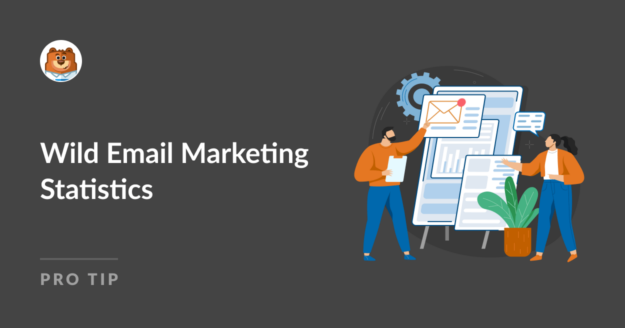AI Summary
Want to see some crazy email marketing statistics?
Amidst the buzz of new technologies like AI, email marketing firmly holds its ground as one of the highest ROI and most accessible marketing strategies. It continues to be a must-do strategy for small businesses and entrepreneurs, offering the ideal combination of reach, accessibility, and effectiveness.
In this post, we take a deep dive into the latest email marketing statistics and trends, highlighting how you can make the most out of this tried-and-true marketing channel.
Wild Email Marketing Statistics
Ready to see why email marketing is such a powerhouse when it comes to running a business? Below is the ultimate list of email marketing statistics.
In This Article
- Email Marketing Statistics – the Highlights
- Email Metrics and Benchmarks
- Email Marketing Optimization Statistics
- B2B Email Marketing Statistics
- B2C and eCommerce Email Marketing Statistics
- Mobile Email Marketing Statistics
- Email Marketing Personalization and Automation Statistics
- AI In Email Marketing Statistics
- Email Deliverability Statistics
- Email Spam Statistics
Email Marketing Statistics – the Highlights
Short on time? Here’s a quick rundown of some key email marketing statistics. Discover insights into the remarkable ROI that email marketing continues to offer, understand the expanding landscape of email users, and get a snapshot of the latest open and click-through rates.
1. The ROI of email is one of the highest of any marketing channel, offering an impressive average of $36 for every $1 spent. (Constant Contact)
2. The global email marketing revenue was measured at $7.5 billion in 2020 and is expected to meet $17.9 billion by 2027. (Statista)
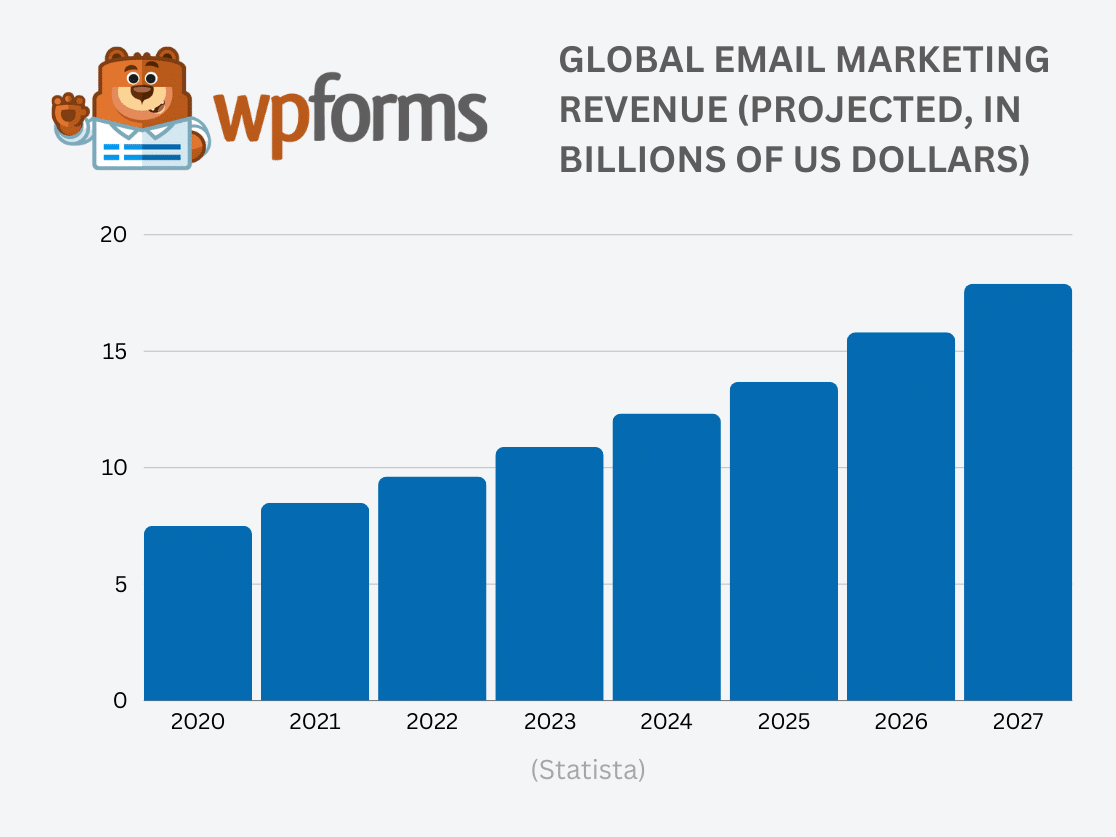
3. The number of global email users is on track to exceed 4.48 billion in 2024 – more than half the population. (Statista)
4. 333.2 billion emails were sent each day in 2022. This figure is predicted to increase to 392.5 billion by 2026. (Statista)
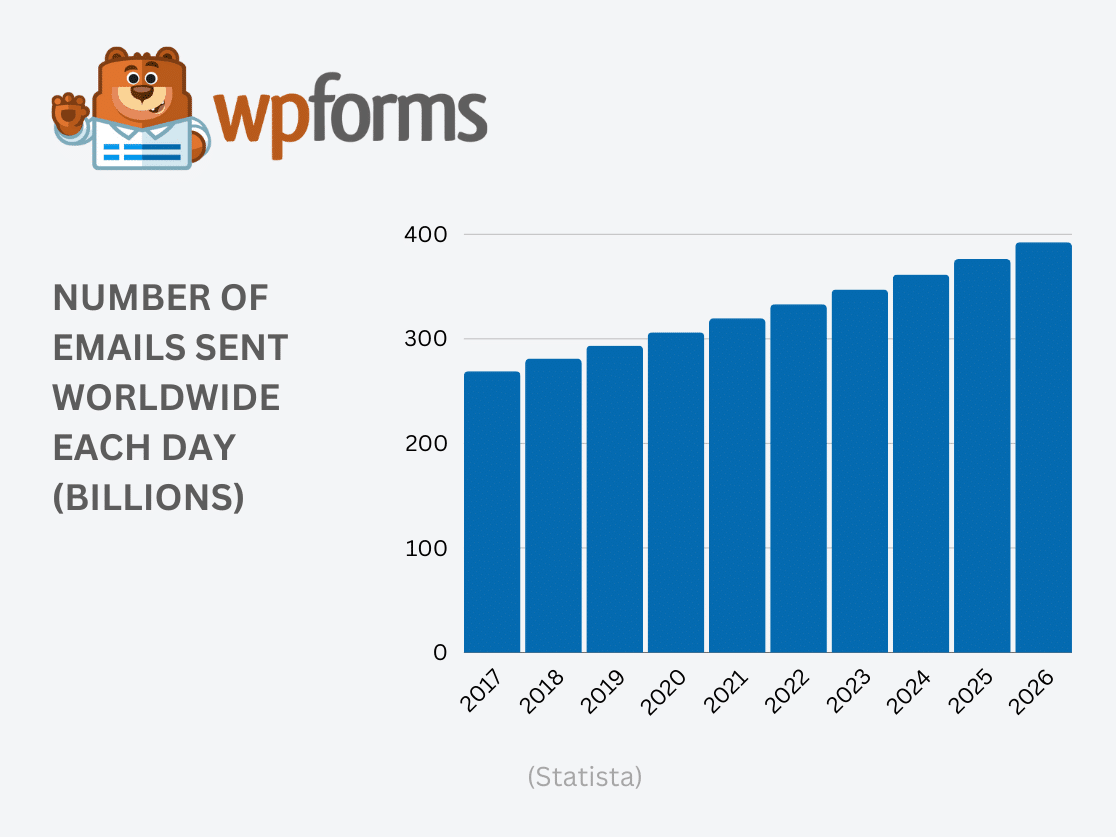
5. Two-thirds of marketers distribute content through email. (Content Marketing Institute)
6. Up to 50% of all email opens happen within the first 8 hours after sending. (GetResponse)
7. Email marketing campaigns can have 50 to 100 times the click-through rate of Twitter and Facebook. (Mailmunch)
8. 63.3% of people check their emails at least twice a day and 25.4% of respondents check their emails more than five times a day. (Mailjet)
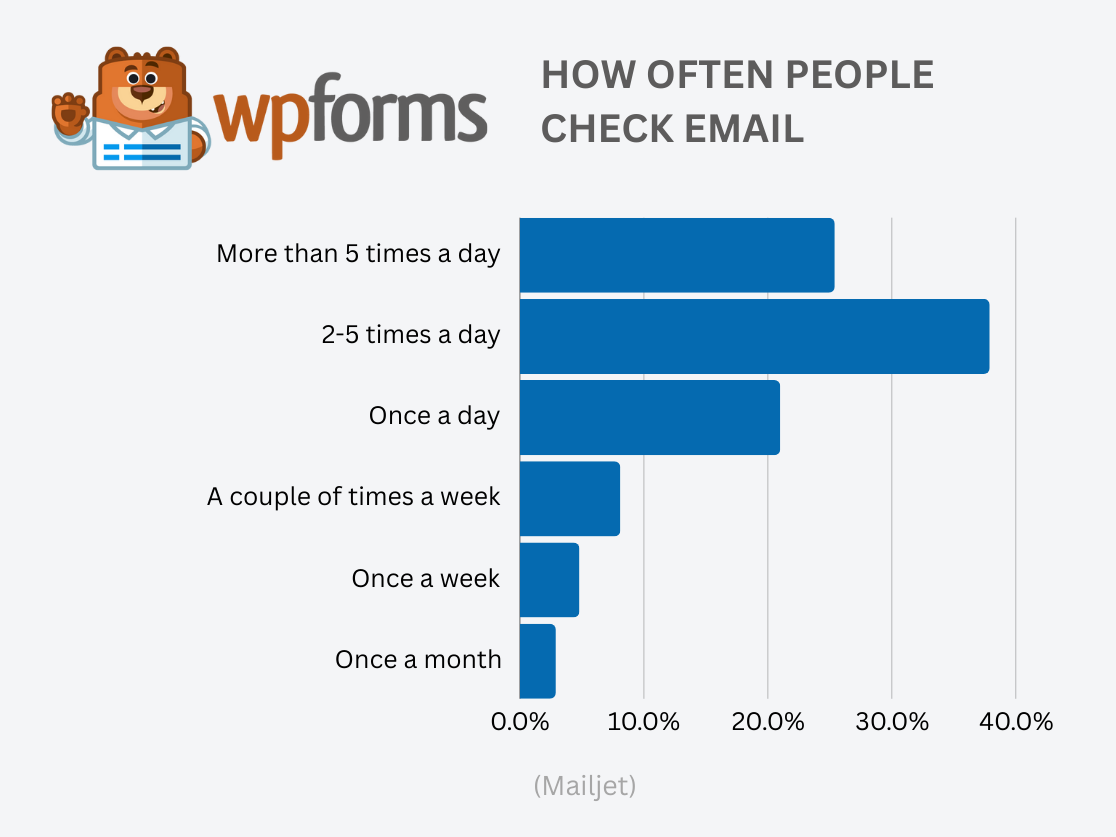
9. 53% of brands take 2 weeks or more to produce an email. (Litmus)
10. 73% of marketers consider email to be important to the company’s success. (Litmus)
11. 86% of marketers said that data privacy changes (such as Apple’s Mail Privacy Protection) have impacted their marketing strategy over the last year. (Hubspot)
12. 51% of marketers say email marketing is their most effective marketing channel. (Hubspot)
13. 33% of marketers planned to increase their email marketing budget in 2023. (Hubspot)
14. 33% of marketers send weekly emails. (Hubspot)
15. 41% of marketers say building emails is their biggest challenge, designing is cited by 40% and testing by 39%. (Litmus)
16. The average open rate for marketing emails is around 46-50%. (Hubspot)
17. Consumers spend an average of 10 seconds reading a brand email. (Statista)
18. 44% of CMOs say that email marketing is essential to their overall digital marketing strategy, dedicating 8% of their marketing budget to the channel. (Gartner)
Email Metrics and Benchmarks
In the world of digital marketing statistics, email continues to be a high performer, underscored by impressive metrics. Here we explore the effectiveness of email marketing by investigating engagement metrics, average conversion and open rates, and other benchmark data you can use to evaluate the success of your email marketing campaigns.
1. The average email open rate across all industries is 21.33%. Government emails see the highest open rates at 28.77%, while the vitamin and supplement industry has the lowest average open rates at 15.03%. (Mailchimp)
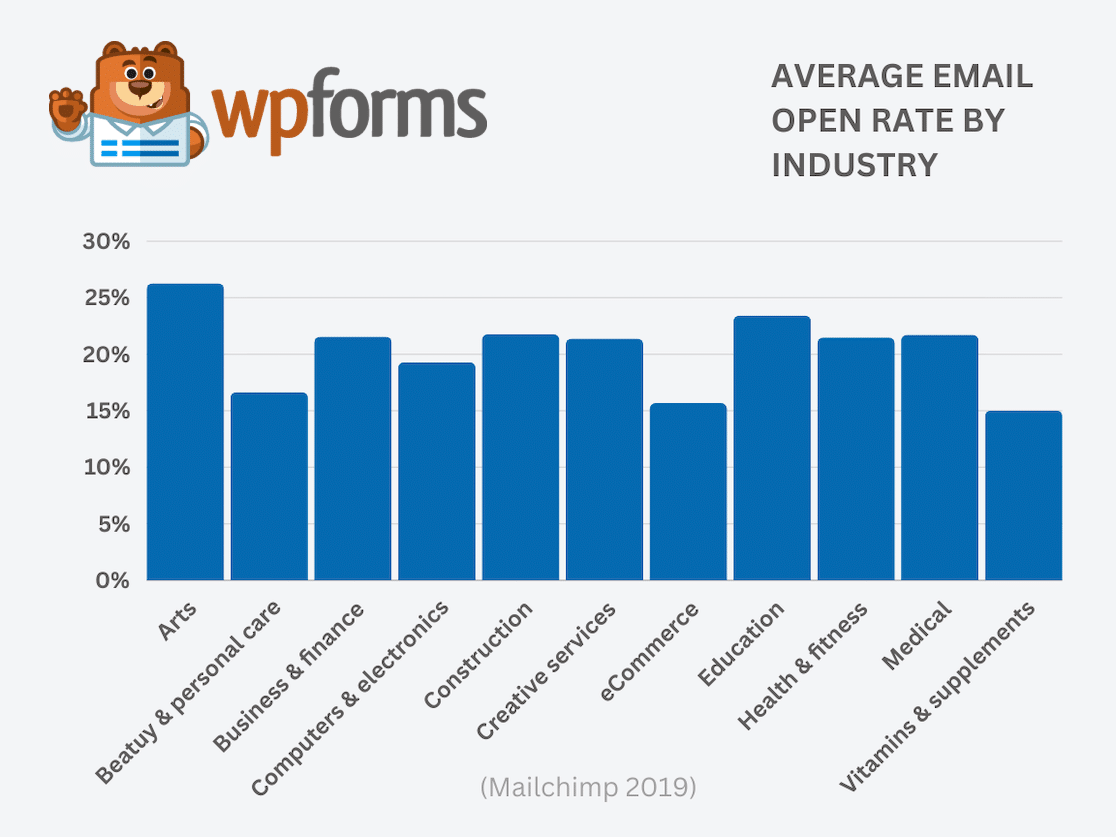
2. The average click-through rate for all industries is 2.62%. (Mailchimp)
3. Emails with a preheader have an average open rate of 32.95% compared to 25.72% for those without a preheader. (GetResponse)
4. Welcome emails have an average open rate of 63.91% – one of the highest rates of any type of email. (GetResponse)
5. Including certain words in your email subject lines may boost your open rates. Some of the top-performing words in terms of open rates include “update”, “events”, month names, “now”, “infographic”, “newsletter”, “news”, “wanted”, and “prize”, all of which have an average open rate of over 35%. (GetResponse)
6. Landing pages that promote a webinar are the highest-converting type of landing pages at an average conversion rate of 22.84%. (GetResponse)
7. The average email click-to-open rate is 7.01%. (GetResponse)
8. The average unsubscribe rate is 0.17%. (Campaign Monitor)
9. Single-message autoresponder emails such as welcome emails have the highest open rate of any other type of email at 94%. The click-through rate for this type of email is also high at 31.43%. (GetResponse)
Email Marketing Optimization Statistics
So how should you start to optimize your email marketing strategies? These statistics reveal the impact of various optimization techniques. From crafting compelling subject lines to perfecting email timing, these insights are crucial for enhancing your email engagement.
1. Using CTA buttons instead of links in emails can increase click-through rate by 28% or more. (Campaign Monitor)
2. 47% of email recipients open an email based on the subject line alone. (OptinMonster)
3. 88.7% of respondents say recognizing the sender is an important factor in determining whether to open an email. (Mailjet)
4. 43.6% of people agree that it’s very important that the subject line of the email suggests the content is personalized to their interests. (Mailjet)
5. 30% of Brands Add A/B Tests to at Least Half of Their Broadcast and Segmented Emails. (Litmus)
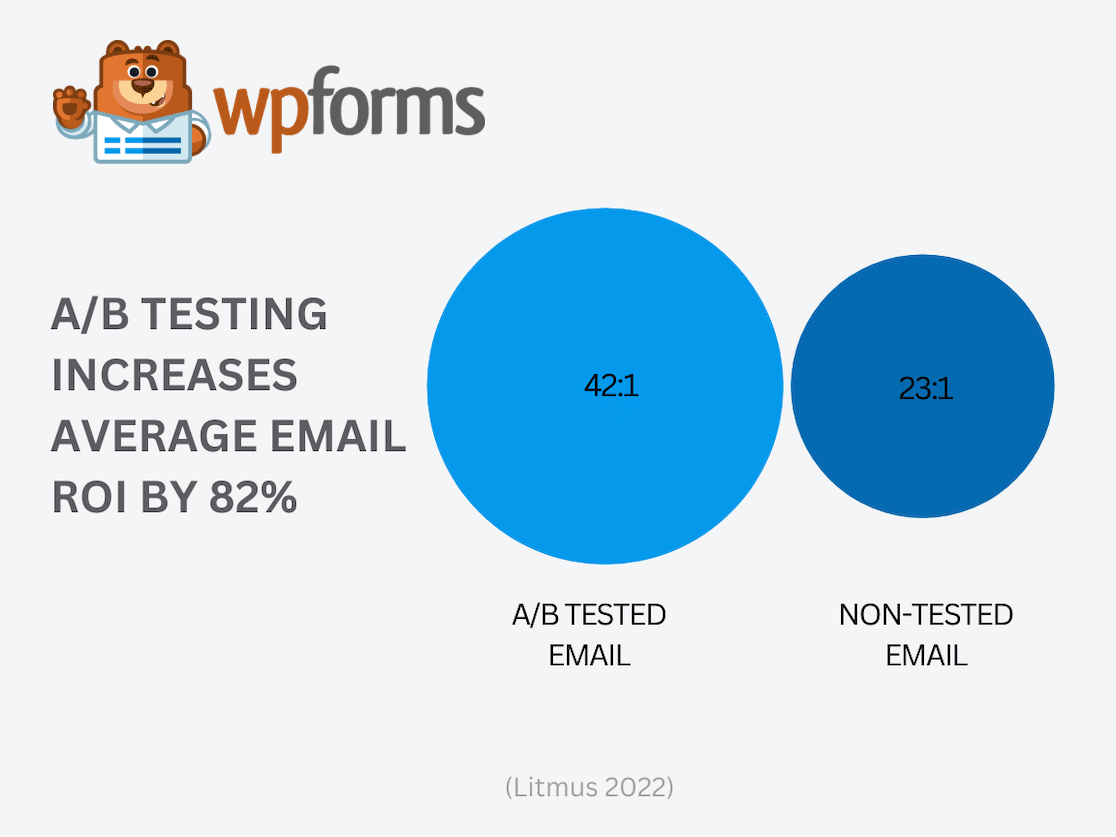
6. 43% of brands don’t test every email they send. (Litmus)
7. 72% of marketers monitor their delivery rates and inbox placements. (Litmus)
8. 65% of brands allow users to sign up for a newsletter on their website but only 49% explicitly describe the benefits of signing up. (Gartner)
9. Only 1% of marketers ask for email frequency preferences on signup. (Gartner)
10. 46% of surveyors said that a minor email marketing mistake they made in 2022 was not optimizing for dark mode. (Mailmodo)
11. The highest engagement for marketing emails occurs between 9 AM to 12 PM and 12 PM to 3 PM. (Hubspot)
B2B Email Marketing Statistics
Now, we’ll turn our attention to the world of business-to-business (B2B) marketing. If you work in a B2B industry, you’ll need to understand how businesses communicate effectively with each other through email and how B2B audiences respond to various types of email content.
1. 44% of B2B marketers say email marketing is the most effective marketing channel. (Hubspot)
2. 83% of B2B marketers say they use email engagement as a metric to track content performance. (Content Marketing Institute)
3. 73% of B2B marketers use email newsletters to distribute content. (Content Marketing Institute)
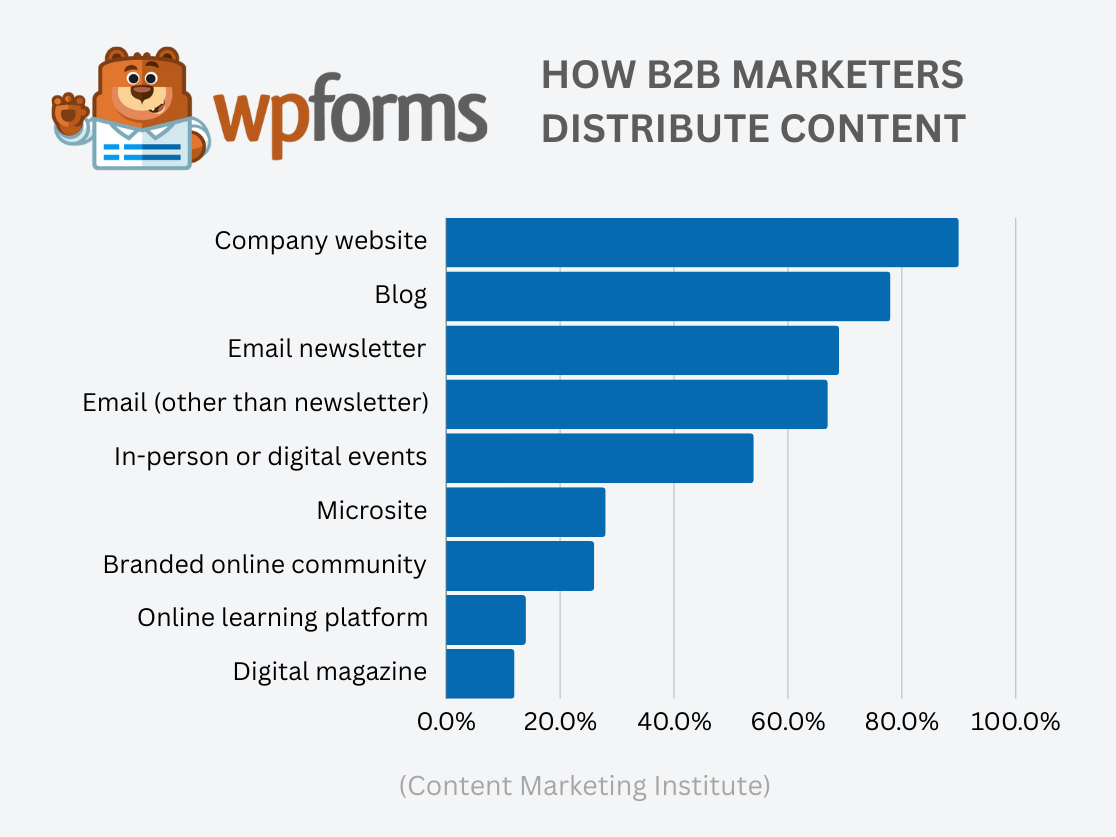
4. 75% of B2B marketers use email marketing software to assist with content marketing. (Content Marketing Institute)
5. 64% of marketers say email engagement and 32% say the number of email subscribers provide the most insight into B2B content performance. (Content Marketing Institute)
6. 81% of B2B marketers say email newsletters are their most used type of content marketing. (Content Marketing Institute)
7. 31% of B2B marketers use email newsletters to nurture leads. (Content Marketing Institute)
8. Email is one of the top 3 organic content distribution channels (along with social media and the company website or blog) used by B2B marketers, with 87% using it. (Content Marketing Institute)
9. 32% of B2B marketers use partner emails as a paid content distribution channel. (Content Marketing Institute)
10. New product and feature announcement emails have the highest click-through rate for B2B marketers. (Hubspot)
11. 67% of B2B buyers set up a junk email account because they’re overwhelmed with the volume of marketing emails. (Gartner)
12. 82% of American workers check work emails outside of working hours. (Statista)
B2C and eCommerce Email Marketing Statistics
These statistics reveal how email marketing shapes the consumer experience and drives online shopping behavior. We’ve investigated key metrics such as the effectiveness of different promotional strategies in email and the role email plays in the customer journey from discovery to purchase.
1. 50% of B2C marketers say growing their email list is one of the biggest challenges of their role. (Hubspot)
2. Over 64% of small businesses use email marketing and 71.8% use emails for regular customer communications. (Campaign Monitor)
3. 31.7% of respondents have a dedicated email address for promotional emails (Mailjet)
4. 50.2% of consumers say they would click through to learn more about the offer or use the promo code on a discount email. (Mailjet)
5. 19% of Americans receive over 50 emails a day, making visibility in a cluttered inbox quite a challenge. (Mailjet)
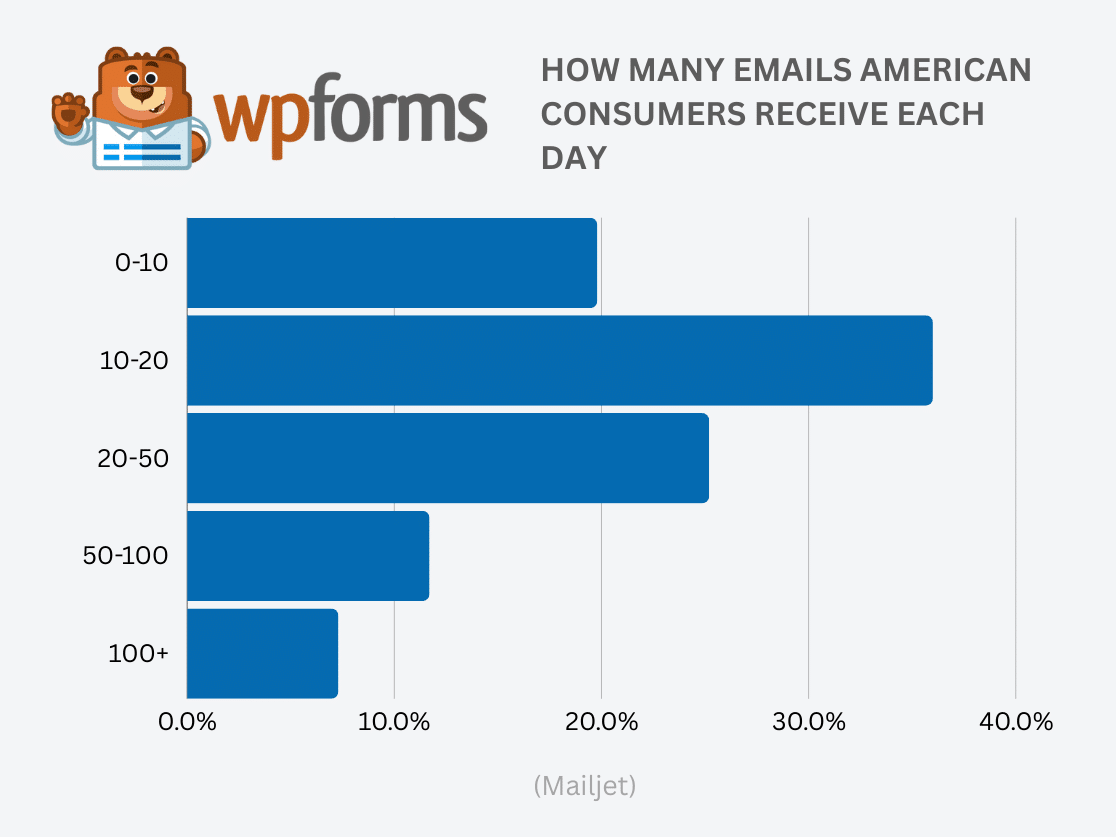
6. 78.5% of respondents want to hear from the brands they love at least once a week. (Mailjet)
7. 56.4% of respondents say they subscribe to regularly receive special offers, and 52.5% sign up for newsletters to receive a one-off discount. (Mailjet)
8. 13% of non-profit donations are generated from email appeals. (EveryAction)
9. Double optin is in use by over 26.6% of brands in the publishing industry but only just over 3% for brands in the retail industry. (GetResponse)
10. 27 percent of US consumers stated it was likely or very likely that a brand’s regular newsletter would influence them to purchase something. (Statista)
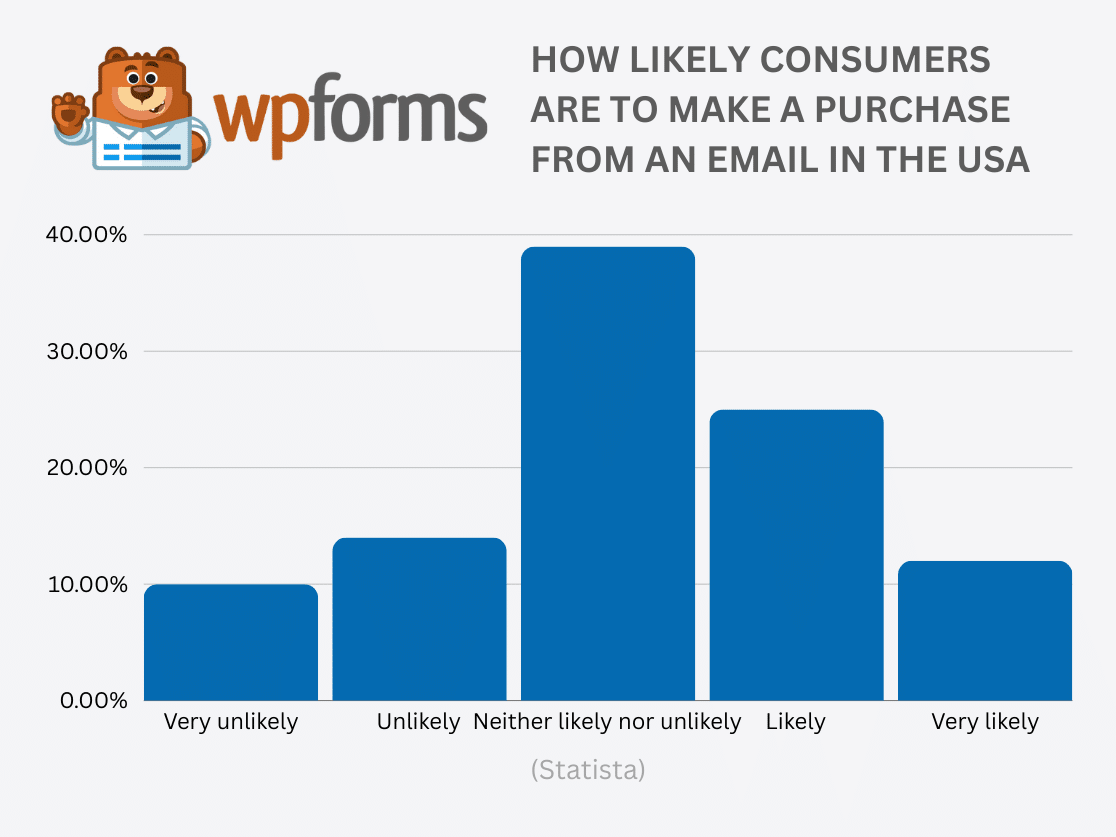
11. Over 57% of marketers say the eCommerce brands they manage have 1,000 to 10,000 subscribers on their email lists. (Hubspot)
12. 85.7% of eCommerce marketers say increasing brand awareness is the main goal of their email strategy. (Hubspot)
13. 72% of eCommerce marketers agree their biggest email marketing challenge is low open rates. (Hubspot)
13. 59% of Americans say the emails they receive aren’t useful to them (Edison Mail)
Mobile Email Marketing Statistics
With each year that passes, mobile marketing continues to be more important to overall strategy. The email marketing statistics below highlight the significance of mobile optimization in email campaigns. This data is essential for ensuring your email marketing strategy aligns with the mobile-centric habits of today’s consumers.
1. Over 58% of emails are opened in the Apple Mail app (found on iPhones and iPads). Apple’s Mail privacy prevents further breakdown. However, earlier years’ statistics suggested that over 40% of emails were opened on a mobile device. (Litmus)
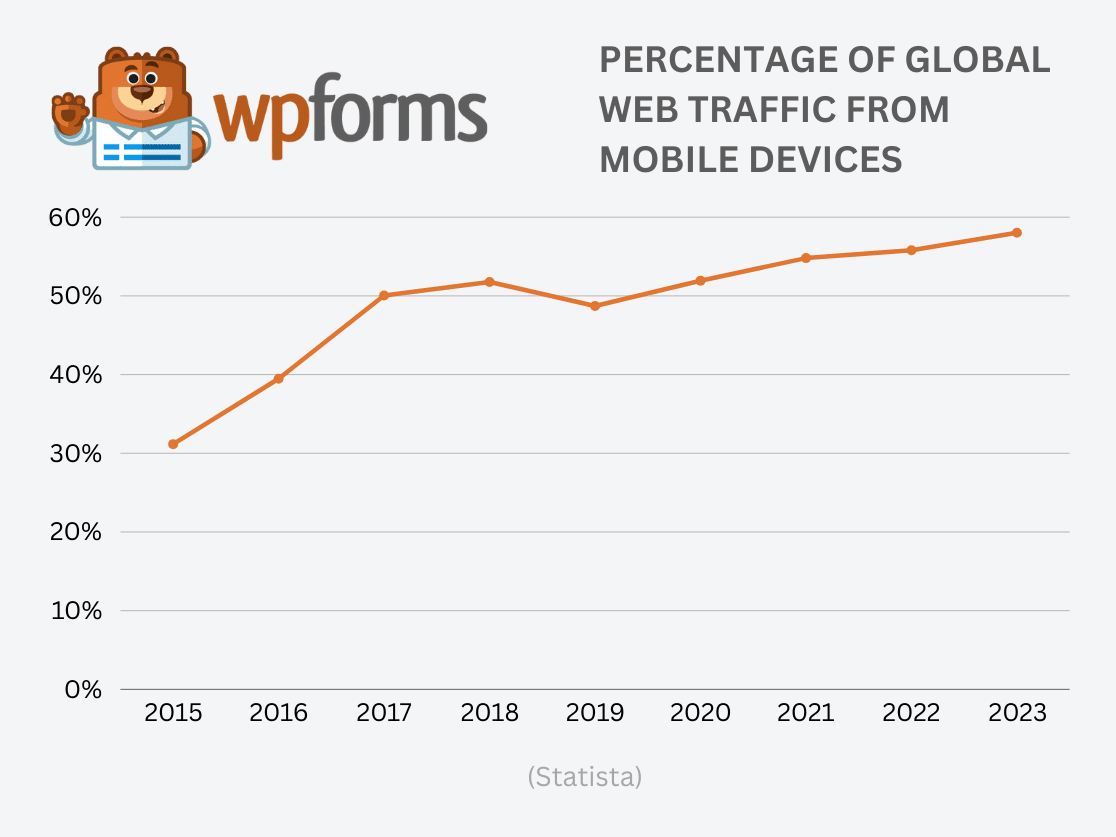
2. 35% of email marketers use a mobile-first or responsive email design process. (Litmus)
3. Readers are less likely to click emails on mobile. Mobile devices account for only 18% of clicks despite making up around 50% of email opens. (Mailchimp)
4. Using Responsive email designs can increase clicks by 5-15%. (Mailchimp)
5. 70% of emails will be deleted within 3 seconds if they display poorly on a mobile device. (Campaign Monitor)
6. 66.7% of marketers send emails to different devices to manually check the responsiveness of their emails. (Mailmodo)
Email Marketing Personalization and Automation Statistics
Understand the trends in using data-driven personalization, the effectiveness of automated email workflows, and how these tactics are reshaping the way businesses connect with their audiences.
1. 78% of marketers agree subscriber segmentation is the most effective strategy for email marketing campaigns, followed by personalization (72%), and automation (71%). (Hubspot)
2. 80% of marketers personalize emails with profile data and 64% personalize them by segment. 42% use past email interactions and 40% use the location of the subscriber. (Litmus)
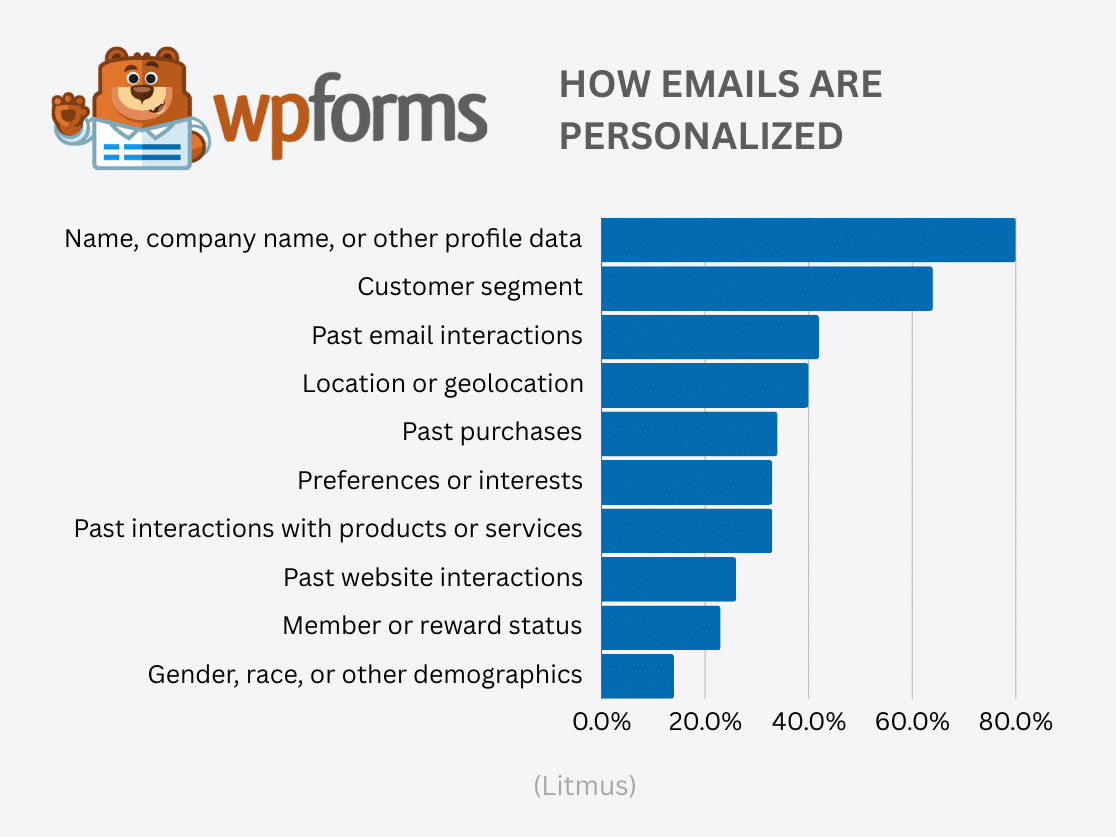
3. 31% of brands use personalized subject lines in email campaigns. (Gartner)
4. Email subject lines personalized with a name boost open rates by 10-14%. (OptinMonster)
5. Automated emails generate 320% more revenue than non-automated emails. (Campaign Monitor)
6. 38.6% of marketers said they didn’t send any campaigns with subject line personalization in 2022. (Mailmodo)
7. 52.6% of surveyors didn’t send any emails in the local language in 2022. (Mailmodo)
AI In Email Marketing Statistics
In this section, we explore the fascinating intersection of Artificial Intelligence (AI) and email marketing. These statistics demonstrate the growing influence of AI in enhancing email marketing strategies. We’ll examine how AI is being used to optimize email content, improve personalization, and increase overall campaign effectiveness.
1. 51 percent of respondents believed that AI-supported email marketing was more effective than traditional email marketing approaches. (Statista)
2. 28% of marketers use generative AI to create and answer emails. (Hubspot)
3. 68% of marketing leaders agree that if AI and automation were fully automated in their business, it would see unprecedented growth. (Hubspot)
4. 71% of marketers report positive ROI from the use of AI and 72% say it makes them more productive. (Hubspot)
5. The top uses of AI in automation include creating content (48% of marketers), analyzing and reporting on data (45%), learning how to do things (45%), and conducting research (32%). (Hubspot)
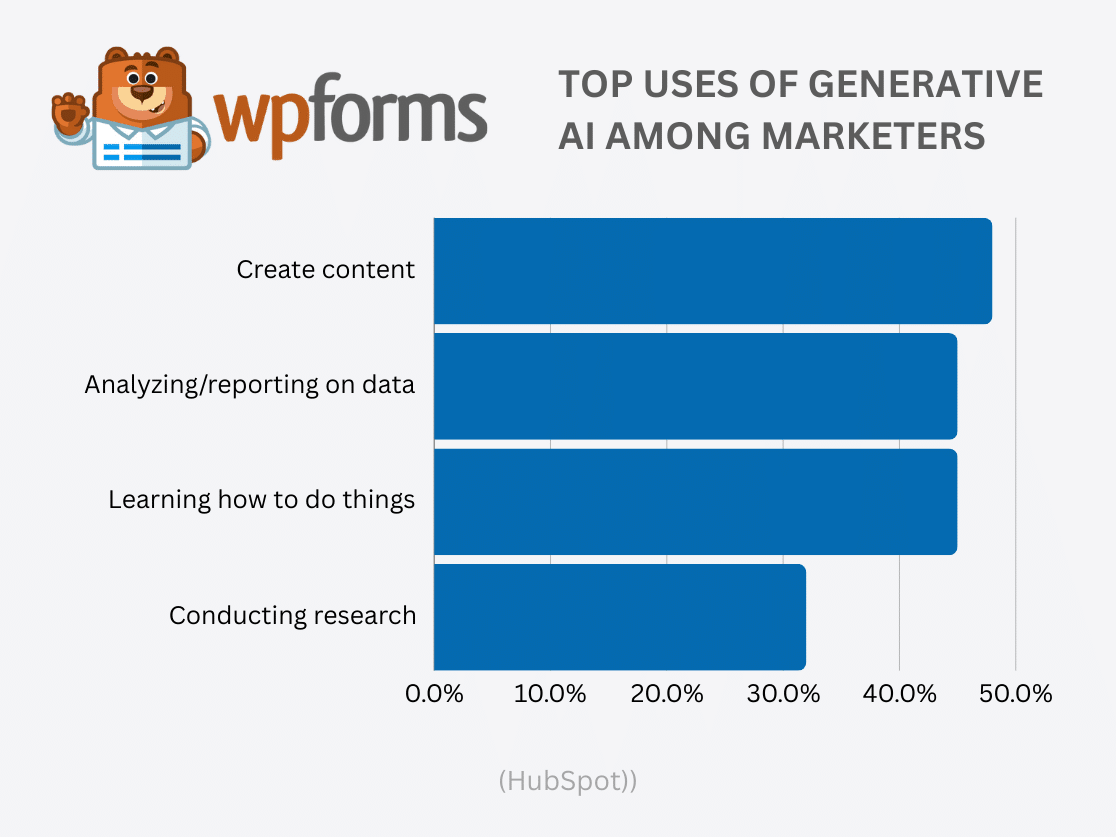
6. 90% of marketers say AI and automation help them spend less time on manual tasks. (Hubspot)
7. When using generative AI to write copy, just 5% of marketers use it to write entire pieces of content for them. About one-third (35%) lean on generative AI to get ideas or inspiration, another third use it to get an outline down, and 25% use it to write a few paragraphs that they then expand on. (Hubspot)
8. 83% of marketers say that AI helps them create significantly more content than they could without. (Hubspot)
9. More than one in five marketers (21%) use AI to summarize text into key points, which is important for repurposing content across channels. (Hubspot)
10. 45% of marketers use AI to analyze and report on data. (Hubspot)
11. 43% of marketers who use generative AI say that it’s most helpful for creating emails. (Hubspot)
12. 38% of marketers who use AI use it to create emails. (Hubspot)
13. 21% of sales professionals who use AI say it’s most useful for writing emails to prospects. (Hubspot)
14. 32% of marketers find AI most useful for editing content to repurpose it for a different audience. (Hubspot)
Email Deliverability Statistics
Deliverability is a critical yet often overlooked aspect of email marketing. These statistics give greater insight into the factors influencing whether an email reaches the inbox or gets lost in the spam folder.
1. 61% of email senders agree email deliverability is becoming harder. (Validity)
2. The average email deliverability rate across all providers is 85.7%, meaning that 14.3% of emails never reach their intended destination. (Email Tool Tester)
3. Nonprofits lose $92.8 million each year due to spam filters and low deliverability rates. (EveryAction)
4. The average email bounce rate is 2.57%. (GetResponse)
5. Low mailbox usage causes 19% of inbox placement issues. (ReturnPath)
6. At least 22.71% of an email list degrades each year. (ZeroBounce)
7. Typos cause over 10 billion bounces a year. (ZeroBounce)
8. One in ten emails are not accepted by receiving mailbox providers. (Validity)
9. B2B inbox placement could be as low as 68%. (Validity)
10. The real estate industry boasts the highest average deliverability at 971.1%, while finance and insurance is the lowest at 80%. (Validity)
11. 60% of marketers warm up their email domain for at least 21 days before sending emails. (Mailmodo)
Email Spam Statistics
One challenge in communicating via email is tackling the ever-present issue of email spam. These statistics should help to give you an idea of the scale of spam emails, the effectiveness of spam filters, and how spam affects both senders and recipients.
1. Spam accounts for over 48% of all emails sent globally. (Statista)
2. 69% of users report as spam based solely on the subject line. (OptinMonster)
3. The average email spam complaint rate is below 0.01%. (GetResponse)
4. 57.1% of people unsubscribe or mark a message as spam when they receive an unsolicited promotional email from a company, while 40.5% just ignore it. (Mailjet)
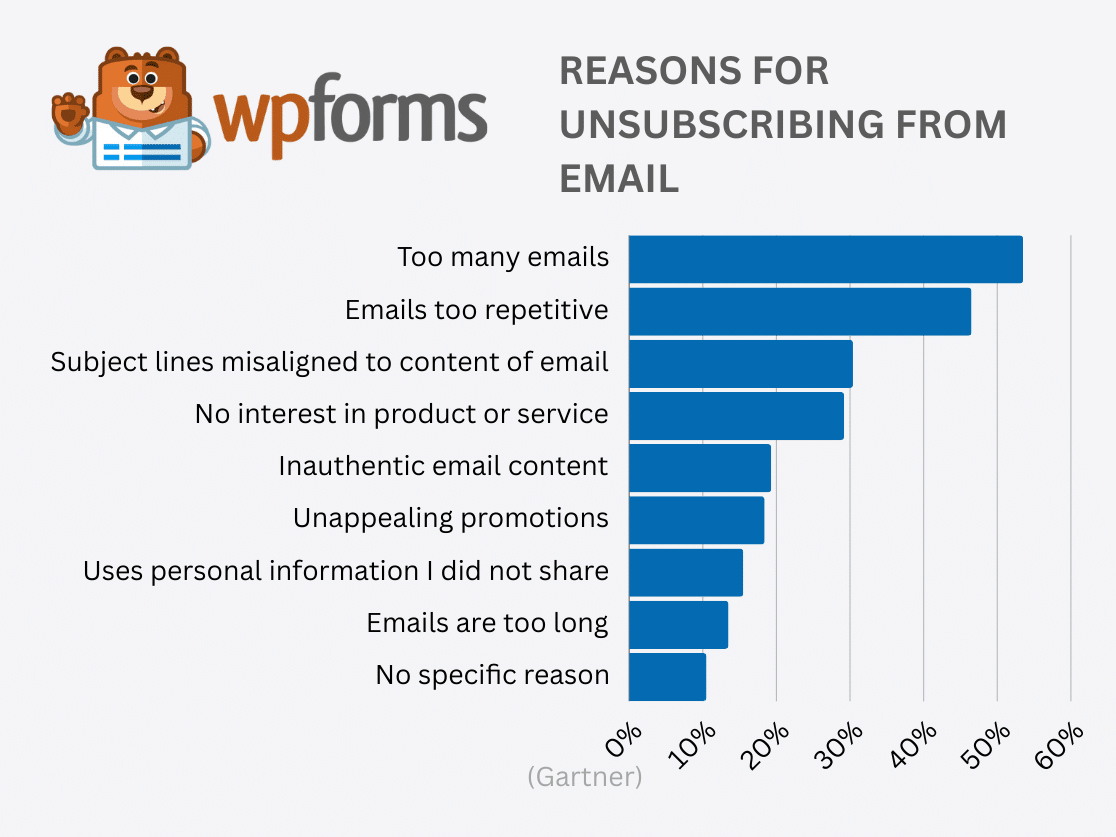
5. Spam complaints account for 21% of email delivery issues. (ReturnPath)
6. Marketing and advertising emails account for nearly 36% of all spam emails. (Mailmodo)
7. Prizes and giveaways are the most commonly seen topic in, with 36.7% of people saying this is one of the top themes they see. This demonstrates how important it is for people to recognize your brand from the sender name when you send out prizes and giveaways by email. (Email Tool Tester)
8. Gmail’s latest AI-powered RETVec spam filter technology, introduced at the end of 2023, has improved spam detection by 38% and reduced false positives by 19.4%. (Folderly)
Growing Your Email List
Now that you see how insanely important email marketing is, you’re probably getting really excited and curious about growing your email list fast. And it’s surprisingly easy to grow your email list, especially if you’ve got the right tools to do it.
So here are some of our favorite, effective tools to use to help skyrocket the growth of your subscriber list and really step up your email marketing game — so you can get in on that 3600% ROI as soon as possible.
1. WPForms
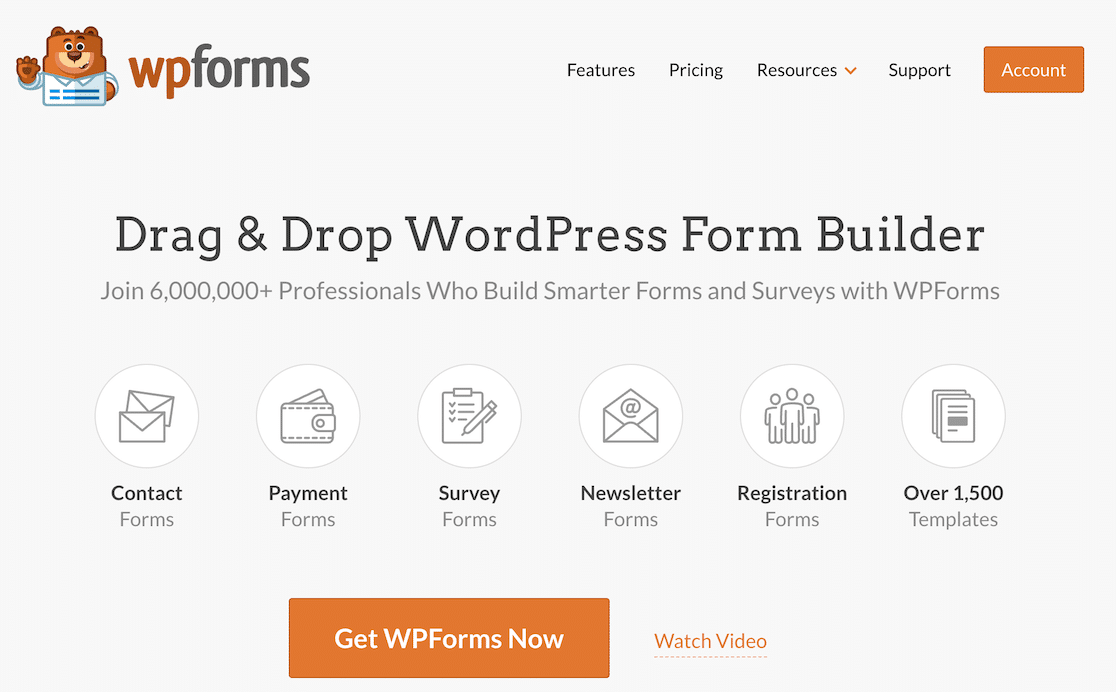
WPForms lets you easily connect your forms to the most popular email service providers, including Mailchimp, Constant Contact, Drip, AWeber, Campaign Monitor, MailerLite, and more. So you can easily add a checkbox on your forms to ask visitors if they’d like to sign up for your email list, and can easily embed your form anywhere in your WordPress site like posts, pages, sidebar widgets, and footers. Best of all, you can also create any type of form like survey forms, file upload forms, order forms, and more.
2. OptinMonster
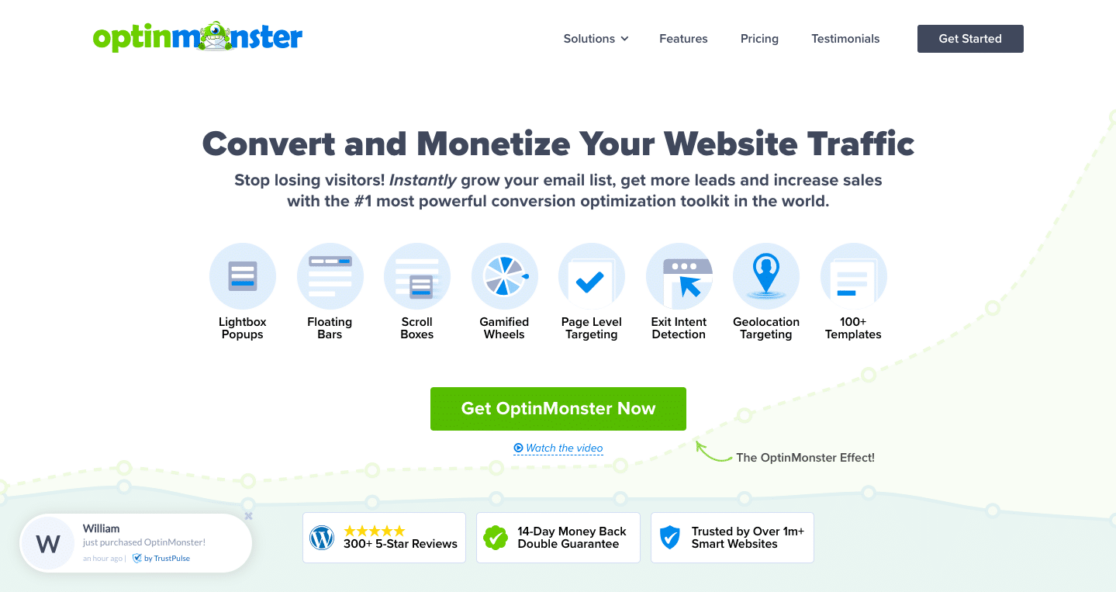
OptinMonster lets you build gorgeous optin forms that are optimized for extremely high conversion rates, making it a great value because of its stunning return on investment rate. And where WPForms is a wonderful contact form plugin, OptinMonster is an independent optin form builder tool that lets you create multiple types of forms such as lightbox popups, floating bars, slide-ins, and more. So you can skyrocket your email list with incredible tools like built-in analytics, A/B testing, Exit-intent technology, and others.
3. RafflePress
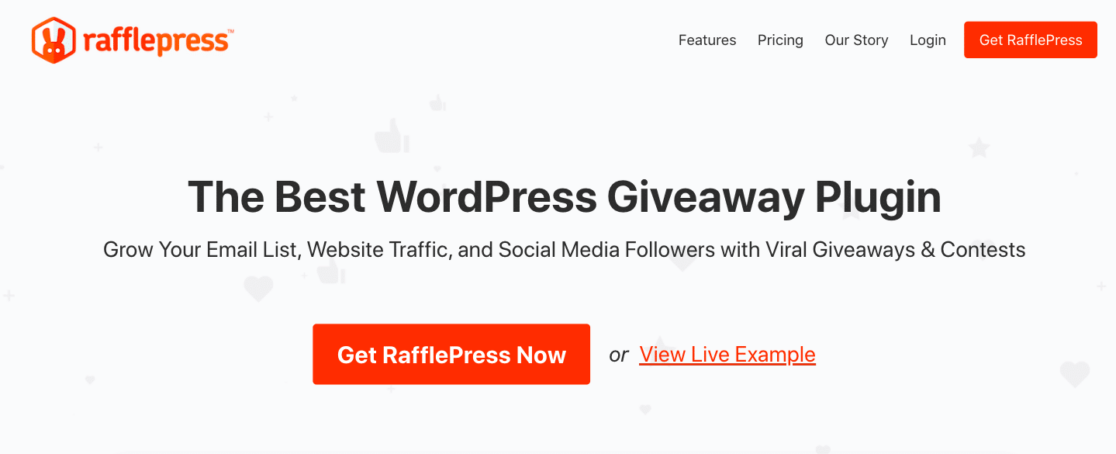
RafflePress is not only the world’s best giveaway plugin, but it’s a tool that can help you grow your email marketing as well. So you can harness the power of viral giveaways through social media that drive users to your site and to your email lists. Plus its easy-to-use drag-and-drop builder makes it super simple to set up a contest and place it anywhere on your site so you can host a giveaway on WordPress.
Alright, I’m Inspired to Grow My List! Now What?
Now that you can see just how effective email marketing is, it’s time to take your site to the next level.
WPForms Pro is the best way to do that because:
- It’s the easiest form builder available for WordPress
- There are 2,000+ WordPress form templates that come with WPForms so you can get started right away
- You can quickly create a Mailchimp subscribe form that you can embed on your site without using any code
- It integrates with Constant Contact, AWeber, GetResponse, Campaign Monitor, Active Campaign, and ConvertKit too.
- And you can also make custom SendFox WordPress forms
- You can push leads directly into your CRM with HubSpot and Salesforce integrations for more streamlined sales workflows.
- The Surveys and Polls addon allows you to gain valuable customer feedback for product/service development and marketing insights.
- When you buy WPForms, you get access to priority support so you can start building your lists faster
- All of your forms will be fully mobile responsive, so your new website will look great on all devices.
Create Your Newsletter Signup Form Now
Next, Start Your First Email Newsletter
And there you have it! You now know some of the biggest and most impressive email marketing statistics around so you can take action on your own email marketing plan.
You may want to check out our tips on how to start a newsletter now that you know how effective email marketing really is.
So what are you waiting for? Get started with the most powerful WordPress forms plugin today. WPForms Pro includes free email marketing integration with the most popular services, plus offers a 14-day money-back guarantee.
And if you like this article, then please follow us on Facebook and Twitter for more updates from our blog.

